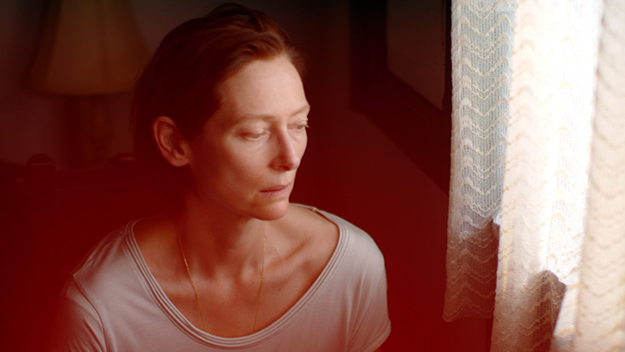Set Diary: Apichatpong Weerasethakul’s Memoria, pt. 5

Tilda Swinton in Apichatpong Weerasethakul’s Memoria
I was invited to follow the shoot of Apichatpong Weerasethakul’s Memoria in order to collect material for an upcoming book to be published by Fireflies Press. This included writing a daily diary of the production, from which the following passages are excerpted exclusively in Film Comment, in serialized form with a new entry every afternoon for the next week. Read the series here.
Day 28—Wednesday, 25 September 2019
It’s coming down in buckets when we board the buses at 4am, and still going strong when we get to the location, a stretch of unused highway at an altitude of 7,500 feet. By the time we finish breakfast, the weather has cleared up, revealing a breathtaking panorama. The valleys all around are filled with a thick sea of clouds, mountain tops jutting out like islands, and plumes of fog drift through the trees as if blown from a giant smoke machine.
A troop of 30 soldiers is waiting near the equipment trucks. All of them look very young—they must be doing military service, so 18 or 19 years old—and are clearly inexperienced, offering us a not particularly impressive marching demonstration. After they’re done I see one of them cleaning his rifle with the barrel propped against his groin. The officer is going around straightening their collars and making sure the gear strapped around their chests is hanging correctly. Camilo says they were likely given new uniforms to make a good impression in the film, he’s never seen them look this clean. “I can’t believe they let us use the real army,” enthuses Apichatpong, whose filmography is replete with soldiers. “You could never do this in Thailand!”
They’re here for a scene of Jessica driving through a military checkpoint, a very common occurrence. What should raise a few eyebrows amongst foreign viewers is that all the soldiers standing along the road, their rifles at the ready, are flashing a thumbs-up at the line of cars waiting to be let through. I’m watching the scene on the monitor with several others from the crew and they tell me it’s a routine practice, introduced about a decade ago as part of a nationwide campaign to encourage people to again travel by car after they were scared off by ‘miraculous fishing’, i.e. kidnappings at road blocks set up by guerrilla or paramilitary groups. “It’s supposed to be reassuring, to let us know the army is looking out for us. A human touch. It’s nice even though it’s kind of weird,” says Santiago. “But what’s even weirder is that it was invented by [Álvaro] Uribe, the worst president we’ve ever had.” Camilo points out the grim irony that under Uribe the army collaborated with paramilitaries and killed thousands of civilians to inflate statistics in the war against the guerrillas and secure U.S. aid packages.
As she drives past, Jessica reciprocates the gesture to each of the soldiers. Juanita [Delgado, Tilda’s Spanish coach] says she always does it as well: “They’re so young, it feels like they have no idea what it is they’re into. I think it’s nice to show them some warmth.”
Day 29—Thursday, 27 September 2019
Another event unfolded quietly in the background of today’s shoot. Shortly before lunch, news arrived of the passing of Luis Ospina, who had visited the set on our third day, a tall man dressed all in black with striking orange glasses. One of Colombia’s most important filmmakers, he was a friend and mentor to many on the crew. They kept their grief discreet, not to disrupt the shoot, and after the set was cleared they gathered by the stream and let a small flower arrangement float away in his memory. R.I.P. Luis Ospina, 14.06.1949 – 27.09.2019
Day 34—Thursday, 3 October 2019
We all get on Willys—the compact WWII US Army jeeps which are the vehicle of choice amongst Quindío farmers—and drive to one of the isolated farms scattered across the mountains that encircle Pijao. The film’s climax will take place in the large farmhouse, set on a steep incline and surrounded by row upon vertiginously stacked row of coffee shrubs and plantain trees. From up here, the view of the valley is spectacular, with Pijao tiny in the distance, recognizable from the church’s bell tower, an orange monolith projecting from the expanse of green.
As with his previous films, Apichatpong has been rewriting the conclusion throughout production to reflect changes in story and mood that developed along the way. After arriving on set, he constructs the scene in a methodical, hands-on manner I’ve not observed before. First, he spends a long time on the production design, re-arranging furniture and props, asking for some pieces to be removed and others replaced. His trademark phrase, “too much,” gets repeated a lot over the next hour or so. The house initially looked like a hoarder’s abode, with clutter and electronic appliances stacked everywhere. When he’s finished, it feels a lot more airy, giving the impression that the occupant is less an eccentric and more a hobbyist who builds quirky inventions from salvaged material.
Although deviations from the storyboard have occurred rarely—Apichatpong is flexible on most elements of the mise en scène, only the frame is virtually untouchable—now he devises all the shots anew. Sompot and Mateo [Suárez, the 2nd AD] stand in for the actors while he circles around them, taking picture after picture with a viewfinder app on his phone. Once he’s determined the compositions, the actors are called in and together they go through the full scene, which spans a good half-hour; he makes sure they’re comfortable with every line, gesture and movement, and modifies the shot sequence accordingly. By the time the blocking is finalized, it’s night and there is time for a single rehearsal before we get back on the Willys and drive home.
Read more here.







